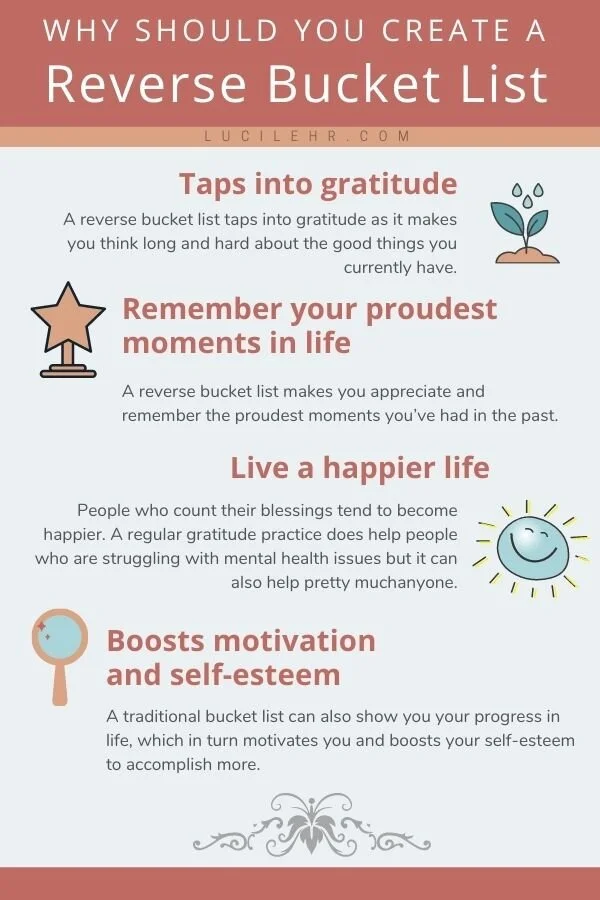Why You Should Have a Gratitude List (Reverse Bucket List)
We all have a bucket list - things we want to do in life - and most of the time, we set a deadline for it. 27 places in Europe to visit before 30, Travel to 52 countries by 25, or just 100 Things to Do Before I Die - the list goes on and on. And you have to admit it: it's easy to get stuck in the comparison game and feel everyone else is doing much more than you, or just moving on to the next goal every time you accomplish something instead of celebrating it.
Have you ever thought of looking at all the positive things you’ve done instead and appreciating them? Can you even remember them? It’s time to change the way you think and give yourself credit for all the things you've accomplished in a reverse bucket list. Think of this as an opportunity to be grateful and thankful for yourself and all the incredible things you’ve accomplished.
Table of Contents
What is a Gratitude List or Reverse Bucket List?
A traditional bucket list is rather easy to make - just imagine the things and the possibilities you can do. While this list can be inspiring and motivating, what happens is that people tend to focus a lot on being and doing more. If you fail at making it happen, you start to feel as if you’ve been left behind instead of being grateful for how far you've made it.
A reverse bucket list, is, as expected, the total opposite of what a traditional bucket list. It is a mindful exercise that involves reflecting on all the things you've accomplished and feeling grateful for them. It can even help you connect the dots, see trends in what you enjoy doing and even connect with your personal purpose.
Why should you create a Reverse Bucket List?
A reverse bucket list taps into gratitude as it makes you think long and hard about the good things you currently have. It also makes you appreciate and remember the proudest moments you’ve had in the past.
Several studies have shown that people who count their blessings tend to become happier: According to this study found in the journal Psychotherapy Research, a regular gratitude practice does help people who are struggling with mental health issues but it can also help pretty much anyone.
A traditional bucket list can also show you your progress in life, which in turn motivates you and boosts your self-esteem to accomplish more.
Insane athlete, absolute badass and retired Navy Seal David Goggins, uses a similar method he calls the Cookie Jar to keep him going for all the ultra-marathons that he had joined on top of being a Guinness World Record holder for the 4000 pull-ups done in 17 hours.
I personally wouldn't recommend you do an ultra-marathon with no previous training or run on broken legs (just don't!) but use his advice in the moments where you just want to give up and open your mental Cookie Jar.
It involves collecting all your past achievements and the obstacles you’ve overcome then storing it in your mind for future use, such as situations when you need that extra boost in motivation.
You know how you’ll have a sense of fulfillment just by seeing your progress? That’s how it is when you focus on your achievements, count your blessings, and realize that you have done things in the past you thought you never could. It can also help you connect the dots between different experiences of your life and know yourself better.
How to Create your Own Reverse Bucket List?
When you are grateful, you celebrate even the littlest of victories. But coming up with a reverse bucket list won’t be as easy as you think because then you would start to focus on the big wins in your life that you’d forget the small, meaningful ones. I suggest taking the steps below for this mindful exercise:
Think of all the things - big and small - you have done in life.
Don’t just focus on big things, include small things you were proud of, even from several years ago.
Let your thoughts overflow with all the positive things that you have accomplished in life
Ask your family and friends or refer to your social media memories
Use a template (which you can download), I have one for you just here:
10 things I included in my reverse bucket list:
Need more inspiration on how to fill up your reverse bucket list? Here are 10 things that made the cut to mine:
I have a native level in 3 languages
I traveled solo for 7 months
I went from picked last in gym class to becoming a Yoga Teacher
I did scuba-diving in Sipadan Malaysia
I lived in NYC
I created my own website (you're on it right now!)
My website was featured on big publications
I've taken the steps to optimize my health
I've done Couchsurfing and experienced different cultures
Writing this just made me feel good! I'm grateful at how much I've done and how I've followed what I wanted to do!
When you have your list, you’ll be surprised at how you’ve been living a pretty amazing life. You can use these positive vibes in times when you feel like you can’t go on and in times when you need that extra push forward. Make adding to your reverse bucket list a monthly or quarterly mindful practice - it’s up to you! You will soon find yourself having the extra motivation to achieve your goals in life.



